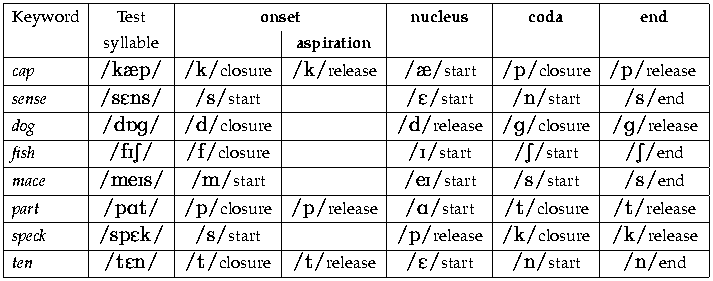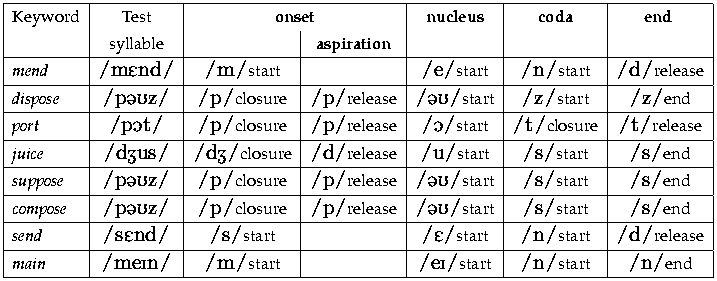EUSTACE
| HOME |
DESIGN |
EXAMPLES |
SENTENCES |
PROCEDURE |
RESULTS |
DISSERTATION |
LICENCE |
DOWNLOAD |
GLOSSARY |
| ||||
|---|---|---|---|---|---|---|---|---|---|---|---|---|---|---|
Procedure: Test syllable labels
The start and end points of subsyllabic constituents of each test syllable were labelled by visual inspection of the waveform and spectrogram using XWaves. For consistency, labelling was performed keyword-by-keyword. To eliminate bias due to the order of labelling, each speaker's four files for each keyword were labelled in random order. The order of speakers for each keyword was also random.
- TEST SYLLABLE LABELLING EXAMPLE: illustrating the labelling scheme for test syllables, explained further below.
Labels are placed for all keywords at the start point of each of
subsyllabic constituent of the test syllable: onset, nucleus, and
coda, as shown in Table 1 and Table 2 (these tables are reproduced
from Appendix E of English speech timing: a domain and locus approach - see DISSERTATION page). The
start of the nucleus marks the end of the onset and the start of the
coda marks the end of the nucleus; the end of the coda is also
labelled. The additional ``aspiration'' labels are explained below.
 |
It should be noted that singleton test syllable coda
consonants could also be regarded as ambisyllabic or as unstressed
syllable onsets in left-headed disyllables and trisyllables: for
example mason and masonry. For consistency, such
consonants are always labelled as codas (note: this decision appears
to be supported by evidence from final lengthening reported in Section
4.8 of the dissertation).
 |
The right-headed port, compose, dispose and suppose, and the left-headed ten, cap and part all have voiceless stops as their syllable onset: these all have an additional label placed at the point of stop release, corresponding to the start of aspiration, as well as the onset label corresponding to the start of consonant closure. (Being preceded by an /s/, the /p/ in speck is unaspirated, and thus did not receive this additional label.) Similarly, the test syllable onset of the keyword juice has a label at the position of plosive release in the affricate syllable onset (as pronounced in British English), corresponding to the start of frication.
The criteria used for segmentation are described in Appendix A of the dissertation. Labels were placed by reference to a speech waveform and a colour wideband spectrogram. For consistent application of visual criteria, judgements were made using a window size of not less than 400ms. As spectrogram colour indicates intensity, the appearance of a particular colour at a particular frequency was sometimes used to aid segmentation, for example, for the start of certain fricative consonants.
Not all constituents of all test syllables are reliably measurable in all contexts. Firstly, the period of stop closure in the syllable onsets for the right-headed keywords compose, dispose, port, suppose and juice does not have an acoustic correlate in utterance-initial position, and thus the ``onset'' label is missing in these cases. Secondly, coda stop consonants are sometimes difficult to measure reliably: the codas of the right-headed port and the left-headed cap, dog, part and speck are all occasionally elided or glottalised and thus the ``end'' label may be missing.
Test syllable labelling is discussed further in Section 4.3 of
the dissertation.
| Up to PROCEDURE page | Forward to ADDITIONAL SYLLABLE LABELS page |











![[ intranet ]](/images/menu_intranet.png)
![[ festival ]](/images/menu_festival.png)